
U-Fly-It boss Dennis Carley said they are working on a name. For now, I’ll call the new entry the Electric Aerolite 103 and this machine is ready for market. A few customers already offered payments to get in line (more on that below, too) and one man wrote a check for an Electric Aerolite even while he keeps flying his gasoline-powered Aerolite. How’s that for a vendor’s dream?
Are you ready for electric? It’s ready for you!
“Clean and Tidy”
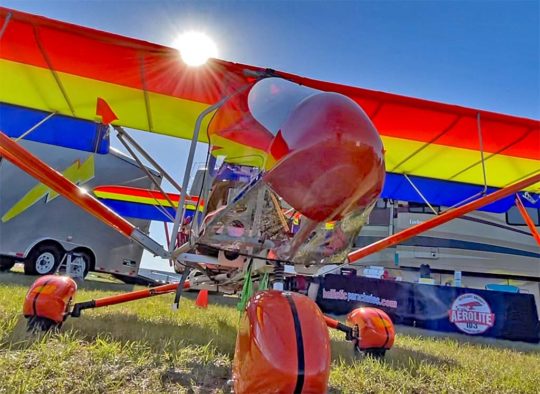
Powered by the sun? Yes, if you have solar collectors on your hangar or house. Whatever the “fuel” source, Electric Aerolite 103 will cost pennies to fly.
You hear that phrase about Aerolite fairly often. A very knowledgeable veteran of the light aircraft business, Scott Severen, spoke of visiting U-Fly-It, producer of the Aerolite. After discovering the production process, Scott came away very impressed with the “efficiency” he witnessed. Space is well used, equipment is properly set up, and staff is well trained and managed to produce these popular machines
The electric installation on Aerolite maintains U-Fly-It’s trademark clean and tidy appearance. The arrangement looks well conceived and executed and with a few minor refinements in hardware to contain the battery packs, the Electric Aerolite is done and will enter production.
Learn and see more about Aerolite in this article (one of the most-read on this entire website).
Part 103 Industry Status
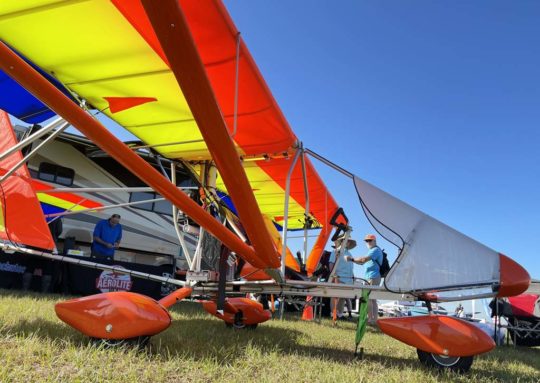
One of the most popular Part 103 ultralights, possibly the market leader, Aerolite 103 is a well proven aircraft with excellent handling, good performance, and most features pilots want, all for a price most can afford.
As most readers know, I am working my way through a list of 58 Part 103 producers to determine the size of the Part 103 industry and its pilot community. I have responses from about a third of those builders and I am determined to chase down every last one to find out how many are produced each year. Today, no one knows this information …NO one knows, not FAA, not member organizations, and guessing about the figures is a matter of speculation and conjecture.
However, I hope to eventually correct this information shortfall and I believe many will be surprised. I am sticking to my prediction that in unit volume, Part 103 deliveries may pass registrations of Special Light-Sport Aircraft. Wouldn’t that be amazing? Whether you know it or not, I am certain Part 103 aircraft sales are more robust than most think and I believe this has been developing for a few years.
Why Do Ultralights Lead in Electric?
I recall a project to make a Cessna 172 fly with electric propulsion. Did you ever hear how that went? No, you didn’t …probably because it didn’t work well. Electric power isn’t the problem. A Skyhawk is not that efficient an airframe and its base weight and payload demand a large collection of weighty batteries.
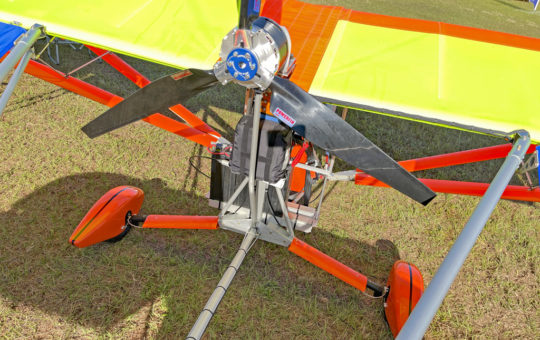
Here’s the business side of Electric Aerolite. A rather tiny-looking motor is mounted slightly above the wing (where heating has proved to be no problem) with the battery packs occupying space formerly used for gasoline. You see three battery packs in position while the fourth has been removed to show visitors.
Big, heavy battery packs are one of the holdbacks in electric propulsion. Although seeing steady improvement — especially with electric cars being pushed by governments in most economies — batteries remain far behind gasoline in energy density.
Ultralights cope with this weight problem simply by requiring fewer battery packs. A light aircraft doesn’t consume electrical energy as fast to get aloft; climbing is where so much juice is used. In contrast, cruising uses far less energy. You knew that, of course, but in the realm of electric propulsion, this difference becomes critical.
Somewhat offsetting that juice drain is the high torque of electric motors; torque is essential to getting airplanes to altitude.
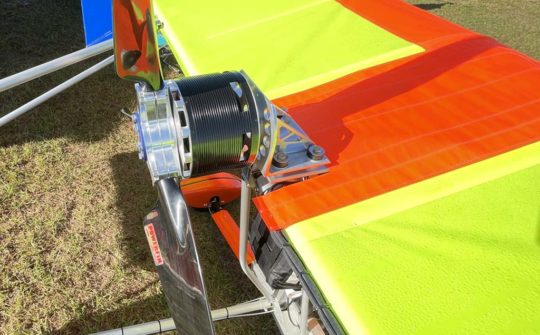
Making 30 horsepower, electric motors show their super efficiency and delivers comparable performance to gas-powered engines while requiring almost no maintenance.
Another major factor in electric Part 103 ultralights leading the charge is usage patterns.
Aerolite says that how you fly is very important relative to battery capacity. Repeated takeoffs and landing (with climbs to pattern altitude) will drain batteries faster than cruising over the countryside.
Part 103 ultralights are often flown in mornings or evenings for 30 minutes and that’s all the pilot needs to acquire a big grin.
So, lighter weight and shorter flight times — both common features on Part 103 aircraft — makes battery power viable now.
A Few Facts
About Electric Aerolite
You’ll want to ask the factory for the best and latest info but following are a few questions and answers I overheard.
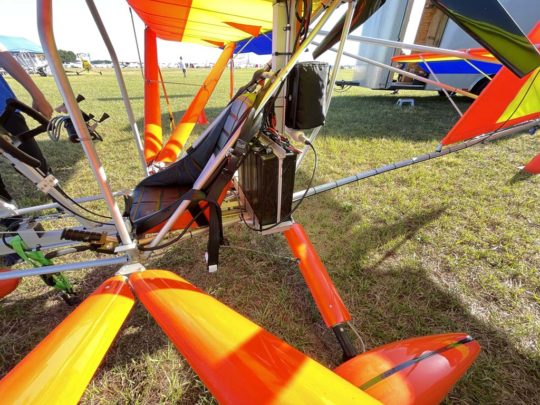
In this view of the battery pack “tray,” you see the prototype version. This will be cleaned up slightly but the method is similar to the way every car battery is carried. A lower tray holds the batteries and a top clamp secures them. Connectors are on the top of the battery packs, well out of harm’s way.
First, you should know that Aerolite 103 is a modest purchase, with gasoline models almost always priced at less than $20,000 in ready-to-fly form. Electric doesn’t change that too much so Aerolite 103 is not only a well-developed aircraft but one you can probably afford (though everyone’s budget is different).
How Long Can You Fly? — Perhaps the most common question is first addressed by talking about how you fly with electric power (see above). But assuming a climb to 700 feet above ground and then cruising at 40-45 miles per hour, two battery packs will last about 30 minutes.
What Is the Maximum Endurance? — While two battery packs are the minimum arrangement (prices below), you can have two, three, or four. If you have four, you can fly for about an hour, again and always dependent on how you operate the powerplant.
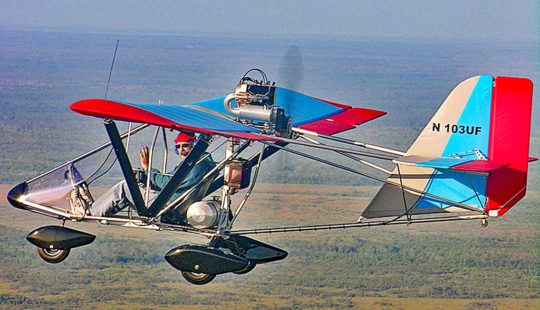
Dennis Carley flies a gasoline powered Aerolite for my camera. Compare the gasoline engine and fuel tank to the images above. Also worth noting is Aerolite’s tail volume. A big vertical stabilizer and rudder are reasons why this popular Part 103 ultralight handles so well.
How Much? — Prices change so if you are reading this in later 2021 or afterward, please check with the factory. However, at Sun ‘n Fun 2021, here are some price estimates.
Two battery packs with electric motor, controller, and all mounts and cables lists at $9,750.
A gasoline engine and fuel tank may cost slightly less but not a big difference. Each extra battery pack is $2,550 additional.
When Can You Get One? — Gasoline or powered, as of Sun ‘n Fun 2021, Aerolite is quoting delivery at eight months for ready to fly or five months for a kit. Yes, business is that good! More than one Aerolite a week leaves U-Fly-It. Based on early response at the show, Dennis feels sure that length will increase. To address faster deliveries he is working with three top dealers to help manufacture ready-to-fly models for customers; he’ll supply them with kits. Dealer Rick Hayes told me he has already ordered ten Aerolites in the first quarter of 2021.
Hang onto your headset. Aerolite 103 — already one of the success stories in all of aviation — appears poised to expand their market even further and you benefit through their very affordable prices.


Any data on take off and landing distances?
I am sure that the Aerolite 103 people can give you that information.
I thought there was an interview with another e-ultralight builder (Mark Beierle?) that said something about the FAA being good with the batteries not counting as empty weight as long as they weighed the same as 5 gallons of gasoline… Has there been any more info to affirm or deny that?
That was a popular idea at one time but when replying to a formal petition along these lines, FAA stated, “Batteries are not fuel.”
A key issue not mentioned is weight: what is the weight of the motor and drive and controller, and what is the weight of various battery packs (2, 3, and 4 packs)?
I will try to answer those questions.
From their website:
The entire drive system weighs about 30 pounds. Each battery weighs just under 36 pounds. If you use two batteries, the complete system (controller, cables, and throttle) weighs 101 pounds. With 3 batteries the complete system is 137 pounds and with 4 batteries it is 173 pounds.
Electric ultralights have had problems because of the interpretation that the “empty weight” had to include the full battery pack. How does U-Fly-It address that?
This issue has had some useful clarification but has not been fully resolved. FAA’s legal department has officially stated that “batteries are not fuel.” You can interpret from that as you will.
Good article, Dan. I have always loved the Aerolight. And I have been waiting for somebody to bring to market an electric 103.
As you’ve said, electric ultralights are the logical entry-point for this new technology. Even more than the obvious benefits (clean/quiet/cheap) I think the reliability and safety benefits will quickly make electric ultralights even more desirable than their ICE equivalents. Typical ICE ultralight engines are not known for reliability and longevity.
So… what does the panel look like??
I will investigate further. I did not ask enough questions in that area.
Would like to receive info on e-powered 2-place aircraft.
Comments on epowered a/c.
U-Fly-It can offer their own response but I think a two-seat electric aircraft misses the point of battery power today. Present-day technology works on a very light single place; it is significantly less useful on a two place or larger aircraft both for weight and mission reasons.